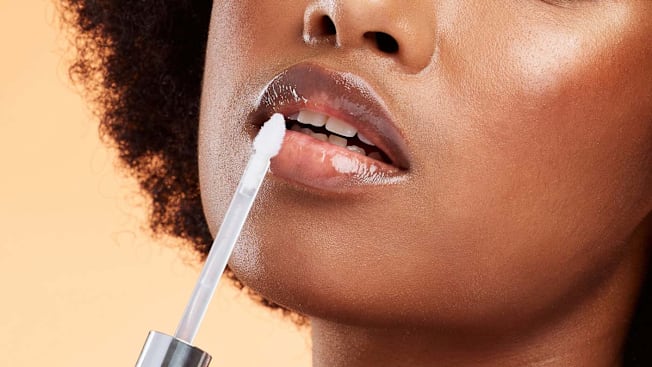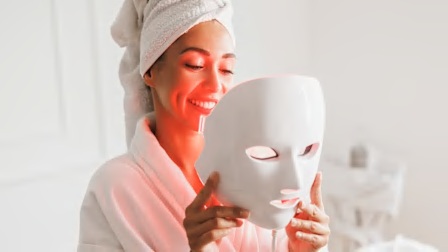Are Lip Balms and Oils Causing Discoloration on Your Lips?
A new hyperpigmentation spot on the mouth may be a sign of an allergic reaction

Podcaster Saron Olkaba’s viral TikTok, “Pigmented Contact Cheilitis,” has sparked a conversation about a lip reaction some people experience but may have never heard of: pigmented contact cheilitis, which Olkaba, a Black woman, says she likely developed after using a lip oil. On her, it presented as excess darkening or hyperpigmentation of her lips.
Mintel research shows that the percentage of Black women who reported hyperpigmentation nearly doubled from 2022 to 2024. Yet many people—particularly those with more melanated skin—may not realize their lip hyperpigmentation or irritation could be due to an allergic reaction, rather than dryness or sun exposure, which can delay proper treatment.
What Is Cheilitis?
According to Cleveland Clinic, cheilitis refers to inflammation or irritation of the lips, which can be triggered by environmental factors or by certain cosmetic ingredients. Olkaba points to propyl gallate—a widely used preservative in cosmetic products—as a possible culprit. While it’s not the most potent allergen—a substance that triggers an allergic reaction—among gallates (a group of chemicals used as preservatives), its widespread use may make it a common cause of allergic reactions.
Getting a Pigmented Contact Cheilitis Diagnosis
Aegean H. Chan, MD, dual board-certified dermatologist and dermatopathologist, practicing in Santa Barbara and Solvang, Calif., notes that pigmented contact cheilitis is underrepresented in medical literature, with only a handful of published case reports. This makes its true prevalence unclear, but it is likely more common than reported.
She adds that delayed diagnosis is common in allergic contact dermatitis of all kinds because the skin inflammation often presents as a nonspecific rash that can be mistaken for other conditions, such as eczema. “It often takes a few visits before a dermatologist or allergist considers that the patient might be experiencing repeated exposure to an allergen,” says Chan.
The gold standard for diagnosing pigmented contact cheilitis is patch testing. This involves applying patches containing specific allergens usually on the back for a couple of days, then reading the results after removal. If a patch site develops a red, raised, or scaly reaction, that’s considered a positive result and confirms an allergic response to that substance.
“When the lips develop dark patches as a result of this allergic inflammation, that’s when we classify it as pigmented contact cheilitis,” says Chan.
Distinguishing Pigmented Contact Cheilitis From Similar Conditions
Pigmentation on the lips can result from various causes, making diagnosis challenging. “If a patient presents without any preceding inflammation, redness, or itchiness, a dermatologist might initially assume the discoloration is a melanotic macule (benign pigmented spots often seen in people of color), rather than something inflammatory, like pigmented contact cheilitis,” says Chan.
Chan says that lip pigmentation can also be mistaken for fixed drug eruptions, which are medication-related reactions causing round, brown patches that may appear anywhere on the body, including the lips. Other possibilities include post-inflammatory hyperpigmentation (darkening of the skin following inflammation), which can be triggered by various inflammatory or autoimmune conditions, such as rheumatoid arthritis or lichen planus. Because this kind of pigmentation is relatively nonspecific, Chan says, “it can make diagnosis more challenging.”
Ready, Set, Gift
CR’s shopping editor shares tips for maximizing your holiday budget in the debut episode of CR’s new podcast, Talking Carts.
Prevention, Management, and Treatment
Topical steroids are commonly prescribed to calm inflammation, though they should not be used long-term. Alternatively, Kikam says doctors can prescribe a non-steroid treatment, tacrolimus, which is a medication primarily used to treat eczema. She also recommends using lip balms with SPF, as protecting the lips from UV radiation can help prevent hyperpigmentation from worsening.
A personalized approach to lip care is often necessary, as each person’s sensitivities and triggers vary. Consulting with a knowledgeable dermatologist can help tailor a prevention and treatment plan to individual needs. “Once a culprit is identified, stopping use can often improve or fully resolve the condition,” Kikam adds.
Cultural and Systemic Insights
The challenges surrounding pigmented contact cheilitis go far beyond individual cases—they underscore persistent gaps in healthcare awareness, access, and education for people with darker skin tones. Diagnosis is often delayed or missed entirely, in part because pigmentation can alter the appearance of skin conditions, making them harder to recognize for clinicians who lack diverse training.
At the same time, the ubiquity of potential sensitizers in everyday lip care products—and the lack of clear labeling—leaves many consumers unaware of the risks. For those affected, finding safe alternatives is often a trial-and-error process that can be both frustrating and costly.
Greater awareness, more inclusive research, and culturally competent care are essential to closing these gaps.




















